

|
| UNITED STATES OF AMERICA | |
| DISTRICT OF COLUMBIA | |
| District of Columbia County |
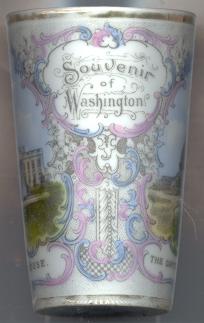
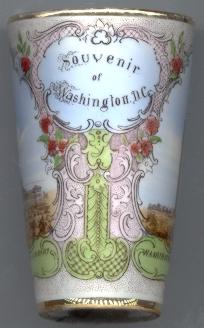 Washington, D.C., is situated at an elevation of 39 ft (11 m) on the left bank of the
Potomac river between Virginia and Maryland. Washington, D.C., is the capital city and
administrative district of the United States of America.
The city has a total area of 68.3 mi² (177.0 km²).
61.4 mi² (159.0 km²) of it is land and 6.9 mi² (18.0 km²) of it is water.
Washington, D.C., is situated at an elevation of 39 ft (11 m) on the left bank of the
Potomac river between Virginia and Maryland. Washington, D.C., is the capital city and
administrative district of the United States of America.
The city has a total area of 68.3 mi² (177.0 km²).
61.4 mi² (159.0 km²) of it is land and 6.9 mi² (18.0 km²) of it is water.
The District of Columbia was founded on July 17, 1790, on land partitioned from Maryland and Virginia. It is a federal district as specified by the United States Constitution with limited—and sometimes contentious—local rule. The land forming the original District came from the states of Virginia and Maryland. However, the area south of the Potomac River (39 mi² or about 100 km²) was retroceded to Virginia in 1847.
The centers of all three branches of the U.S. federal government are in Washington, D.C.,
as well as the headquarters of most federal agencies.
Washington also serves as the headquarters for the World Bank, the International Monetary Fund, and the
Organization of American States, among other international (and national) institutions.
The population of the District of Columbia, as of 2003 U.S. Census Bureau estimates, is 563,384.
The Greater Washington, D.C. Metropolitan Area includes the District of Columbia and parts of Maryland, Virginia,
and West Virginia, with a population surpassing 4.7 million.
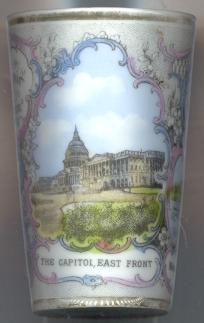
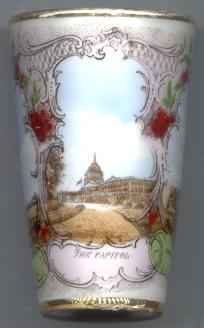
The  United States Capitol serves as home for the legislative branch of the
United States government. It is located atop Capitol Hill. The current building is the fourth to serve as the U.S. capitol,
after the Maryland State House in Annapolis, Maryland (1783–1784),
Federal Hall in New York (1789–1790)
and Congress Hall in Philadelphia (1790–1800).
United States Capitol serves as home for the legislative branch of the
United States government. It is located atop Capitol Hill. The current building is the fourth to serve as the U.S. capitol,
after the Maryland State House in Annapolis, Maryland (1783–1784),
Federal Hall in New York (1789–1790)
and Congress Hall in Philadelphia (1790–1800).
Construction of the current Capitol building began in 1793. The Senate wing was completed in 1800, while the House wing was completed in 1811. The Capitol building held its first session of U.S. Congress on November 17, 1800. Shortly after completion, it was partially burned by the British during the War of 1812. Reconstruction began in 1815, and was completed by 1830. The architect Benjamin Latrobe is principally connected with the original construction and many innovative interior features; his succesor, noted architect Charles Bulfinch, also played a major role. The building was expanded dramatically in the 1850s. The original timber-framed dome of 1818 would no longer be appropriately scaled. Thomas U. Walter was responsible for the wing extensions and the cast-iron dome, three times the height of the original dome and 30 m in diameter. A colossal statue of Freedom was added to the top of the dome in 1863. The East Front of the Capitol building was rebuilt in 1904 to balance the proportions of the huge dome and the façade.
[Other Capitol buildings depicted on items of this collection are the Colorado State Capitol in
Denver, CO, the Massachusetts State Capitol and the Old State House in
Boston, MA, the Indina Statehouse in Indianapolis, IN,
and the New York State Capitol in Albany, NY.]
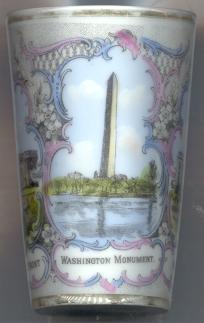
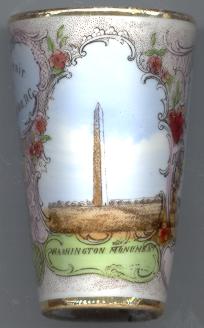
The  Washington Monument is a large white-colored obelisk in the center of the
National Mall in Washington, D.C., built as a memorial to George Washington, the first President of the
United States and the leader of the revolutionary Continental Army, which won independence from the British
following the American Revolutionary War.
Washington Monument is a large white-colored obelisk in the center of the
National Mall in Washington, D.C., built as a memorial to George Washington, the first President of the
United States and the leader of the revolutionary Continental Army, which won independence from the British
following the American Revolutionary War.
The monument is made of marble, granite, and sandstone. It was designed by Robert Mills, a prominent American architect of the 1840s. Its cornerstone was laid on July 4, 1848; the capstone was set on December 6, 1884, and the completed monument was dedicated on February 21 of the following year. It officially opened to the public on October 9, 1888. Upon completion, it became the world's tallest structure (169 m, 554 ft), a title it held until 1889, when the Eiffel Tower (300 m, 986 ft) was finished in Paris, France.
Further monuments to the 1st President of the United States depicted on items from this collection are
the Washington Monument in
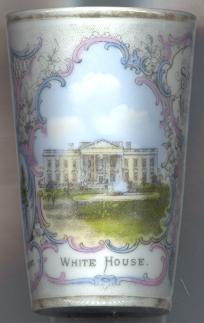
The  White House is the official residence and principal workplace of the
President of the United States. The white painted, neoclassical sandstone mansion is located at 1600 Pennsylvania Avenue.
White House is the official residence and principal workplace of the
President of the United States. The white painted, neoclassical sandstone mansion is located at 1600 Pennsylvania Avenue.
The White House was built after the creation of the District of Columbia by an Act of Congress in December 1790. The architect was chosen in a competition, which received nine proposals. James Hoban, an Irishman, was awarded the honor and construction began with the laying of the cornerstone on October 13, 1792. The building he designed was modelled on the first and second floors of Leinster House, a ducal palace in Dublin, Ireland that is now the seat of the Irish Parliament. Construction of the White House was completed on November 1, 1800.
John Adams became the first president to take residence in the building on November 1, 1800. In 1814, during the War of 1812, much of Washington, D.C. was set alight by British troops, and the White House was gutted. Only the exterior walls remained, but it was rebuilt.
The building was originally referred to as the "Presidential Palace" or "Presidential Mansion".
However, by 1811, the first evidence of the public calling it the "White House" emerged, because of its
white-painted stone exterior. The name "Executive Mansion" was often used in official context until President
Theodore Roosevelt established the formal name by having "The White House" engraved on his stationery in 1901.
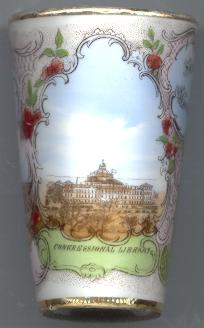
The  Library of Congress is the unofficial national library of the United States.
With over 128 million items, it is the second largest library in the history of the world,
surpassed only by the British Library in London. The library's collections include more than 28 million
cataloged books and other print materials in 470 languages; more than 50 million manuscripts;
the largest rare book collection in North America, including a Gutenberg Bible; and the world's largest collection
of legal materials, films, maps, sheet music and sound recordings.
Library of Congress is the unofficial national library of the United States.
With over 128 million items, it is the second largest library in the history of the world,
surpassed only by the British Library in London. The library's collections include more than 28 million
cataloged books and other print materials in 470 languages; more than 50 million manuscripts;
the largest rare book collection in North America, including a Gutenberg Bible; and the world's largest collection
of legal materials, films, maps, sheet music and sound recordings.
The Library of Congress was established on April 24, 1800, when President John Adams signed an act of Congress providing for the transfer of the seat of government from Philadelphia to the new capital city of Washington. The original library was housed in the new Capitol until August 1814, when invading British troops set fire to the Capitol building, destroying the contents of the small (3,000 volumes) library. As a replacement, retired President Thomas Jefferson offered his personal library which was considered to be one of the finest in the United States. In January 1815, Congress accepted Jefferson's offer, appropriating $23,950 for his 6,487 books, and the foundation was laid for a great national library.
The Library is now spread over three buildings in Washington, D.C.:
(i) the Thomas Jefferson Building (between Independence Avenue and East Capitol Street on First Street SE),
opened in 1897, and long the main building of the Library;
(ii) the John Adams Building (between Independence Avenue and East Capitol Street on 2nd Street SE),
opened as an annex in 1938; and
(iii) the James Madison Memorial Building (between First and Second Streets on Independence Avenue SE),
opened in 1981 as the new headquarters of the library.
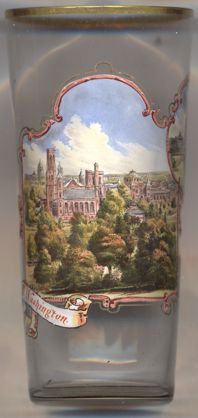
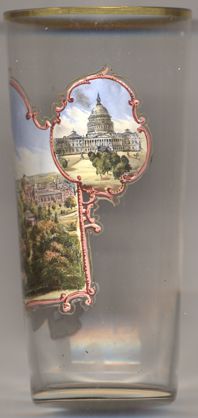
The  Smithsonian Institution Building [left, no. 3989: large picture] was constructed of Seneca red
sandstone in the Norman Revival style (a 12th-century combination of late Romanesque and early Gothic motifs; built in the Gothic and Romanesque revival
styles) and is nicknamed The Castle. It was designed by the architect James Renwick, Jr., and was completed in 1855. It was designated
a National Historic Landmark in 1965.
Smithsonian Institution Building [left, no. 3989: large picture] was constructed of Seneca red
sandstone in the Norman Revival style (a 12th-century combination of late Romanesque and early Gothic motifs; built in the Gothic and Romanesque revival
styles) and is nicknamed The Castle. It was designed by the architect James Renwick, Jr., and was completed in 1855. It was designated
a National Historic Landmark in 1965.
The Smithsonian Institution, also known simply as
The Smithsonian, is a trust instrumentality of the United States composed as a group of museums and research centers. It was founded in 1846,
"for the increase and diffusion of knowledge". The institution is named after its founding donor, British chemist and mineralogist James Smithson. It was
originally organized as the "United States National Museum", but that name ceased to exist as an administrative entity in 1967. Termed "the nation's attic"
for its eclectic holdings of 154 million items, the Institution's 19 museums, 21 libraries, nine research centers, and zoo include historical and
architectural landmarks, mostly located in the District of Columbia.[Additional facilities are located in Maryland, New York, and Virginia. More than 200
institutions and museums in 45 states, Puerto Rico, and Panama are Smithsonian Affiliates.
[http://en.wikipedia.org/wiki/Washington,_D.D.;
http://en.wikipedia.org/wiki/United_States_Capitol;
http://en.wikipedia.org/wiki/Washington_Monument;
http://en.wikipedia.org/wiki/White_House;
http://en.wikipedia.org/wiki/Library_of_Congress;
https://en.wikipedia.org/wiki/Smithsonian_Institution, https://en.wikipedia.org/wiki/Smithsonian_Institution_Building]
![[scale]](lineal.jpg)